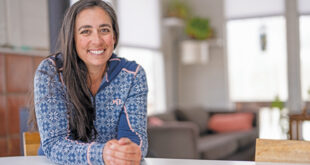Her smile is almost bigger than she is, and her name, Cricket, a tiny creature with a melodic story, perfectly fits her.
Born on Bainbridge Island in Puget Sound, just west of Seattle, to a working father and an educated homemaker mom with a master’s degree in the history of costume, Cricket remembers, “We sewed all our own clothes.”
Arriving well before her time, Cricket was a two and a half pound preemie. “So I was very, very small,” says the still-petite pixie, who spent the first four months of her life in an incubator. When her parents finally brought her home on the ferry, she traveled in a shoebox. Because of her size, she wasn’t allowed to start school until she was eight years old but the upside was, “I got to run around like a wild child. Then they skipped me to third grade.”
Undoubtedly, Cricket’s interest in world cultures was influenced by her love of reading, even before she was in school. “One of my great passions during that time was National Geographic. I learned to read when I was five and I read them all. I was determined that I was going to see the world,” she says, reflecting on the magazine that sparked generations of exploration intrigue.
After graduating from high school in Olympia, Wash., Cricket got a full scholarship to London University. “I was a student at large and could study anything I wanted at any university of the London system,” and since she was fully funded she decided the best use for her college tuition life savings was to buy transportation.
“I went straight to the MG factory and bought myself a new 1965 convertible,” and then she motored on over to the Royal Holloway College in Surrey. “My major wound up being colonial English language literature.” Having easy access to Europe was essentially like living in a National Geographic and she traveled throughout various countries during breaks.
“While I was traveling in Italy I discovered I had a facility for languages. I could learn languages by ear very quickly,” Cricket realized, and she was hired at a branch of Cambridge University to teach English and other languages in Sicily, Florence and Grosetto.
During this tenure, she met an Italian baron who hailed from Sicily. He asked for her hand in marriage. Back in the States to announce her engagement to her family and friends, Cricket’s life was about to evolve into her dream of traveling the world with her husband, when she received a call that the baron had been killed when his car went off a cliff outside of Sorrento. Her plans, her life, everything changed in an instant—and she took off running as fast as she could.
“I traveled through Brazil and Argentina trying to restart my life,” she says, with the harshness of loss somewhat muted by time. Returning once again to the United States, this time Chicago, she met David Farrington, and they married in 1969.
A chef named Giovanni, who took pity on her skinniness, gave Cricket the opportunity to study food informally through the multitudes of weddings and christenings taking place in that traditional Chicago Sicilian culture. She put that experience to use working with her father-in-law.
“Back in the 1960s when people did their entertaining at home on a grand scale, my father-in-law would have these big events, up to 300 people, and we’d cook together. This is where I learned to orchestrate, but I learned the food in Sicily and Florence,” she says and from there, soon after, her life spun itself into a fine food frenzy.
“I disliked Chicago intensely. It was a nasty place!” says Cricket, although she can now laugh about the windy city. “I wanted to raise horses, so we went to Oregon, outside of Portland, and bought a horse farm where I raised Appaloosa-Arab crosses for endurance horses.”
She apprenticed herself to an elderly woman who was a true back-to-the-lander, from whom she learned everything there was to know about early food technology. “Dehydrating, canning, pickling, salting, butchering, raising animals, bee keeping and smoking and curing …all of that stuff,” Cricket says, listing the knowledge that has been lost to the modern generation of fast food culture. All while she was raising horses and farm animals, she began to manifest another dream of hers.
“I had always wanted to adopt Thai children, from the time I was at the Seattle World’s Fair in 1962 and fell in love with the photographs of the children in the Thai pavilion. My sister telegrammed me from her job teaching in Laos that a Thai hill tribe baby girl had been born. There were no adoption agencies there at that time and although babies were coming out of Viet Nam and Cambodia, none were coming out of Laos or Thailand because the governments wouldn’t allow it,” she remembers.
She put together all the pre-work requirements of the American government for adoption and flew to Bangkok to pick up her new daughter—but she wound up living in Bangkok for two years while the Thai powers sent her on wild goose chases for random documentation before they’d let her and her adopted daughter leave the country.
During those two years, she visited virtually all of the countries in Southeast Asia and immersed herself in the various foods. After rounding up a passport and greasing some palms in the process, she finally arrived home with her new baby daughter, Amber, and shortly afterwards gave birth to her son, Spencer. Then the family moved to Washington, D.C., for her husband’s work.
“For the next few years I tried my hand at suburban domesticity, living in a large house in the suburbs and entertaining on a grand scale. Needless to say, that didn’t float my boat,” admits the chef mom. “I was offered a job teaching Asian Cuisines at L’Acadamie de Cuisine in Bethesda, a professional cooking school, which opened the door for me on the bourgeoning Asian restaurant scene in D.C. It was just going crazy.”
Cricket was riding the first wave of the Asian food surge. “I was soon writing food articles for the Washington Post and contributing to the culinary series at Time Life Books, developing recipes and styling food for the cameras.” In 1981, she became the executive chef at the Smithsonian, overseeing all the events and food.
“Roland Mesnier, President Reagan’s newly hired pastry chef and a friend and colleague of mine, gave Reagan my name when he was asked who might be the best Asian chef in town,” Cricket recalls, and a short time later her secretary at the Smithsonian received a suspicious phone call. “’This is Ronnie Reagan and I’d like to speak with Cricket, please,’” she quotes the exact words retold by her secretary, whose natural retort was, “Yeah, right…” Upon which the Gipper demanded, “Young lady, this is your Commander in Chief speaking… let me speak with Cricket.“
That was the beginning of a long series of private parties at the White House for Cricket as The Pres featured soirees with various Asian cuisines. “He wanted someone who could talk about the food with his guests, so I would come to the parties and introduce the evening’s menu. It was fun,” she understates.
Cricket juggled her job at the Smithsonian, where she was in charge of the meals and events that sometimes catered to 16,000 people, simultaneously with the White House gigs. Plus, “I had another baby,” she says lovingly of her daughter, Elin, who arrived in 1984.
“And then I promptly got divorced.” Cricket withstood the constant, hectic schedule of a top chef and single mom of three kids for the next 13 years. “I worked my tail off and I started looking for a place to move to get out of D.C. Someplace where it really felt like home.”
In the spring of 1998, Cricket traveled to Estes Park for a friend’s daughter’s wedding at the Stanley Hotel. Her friends decided to detour to show Cricket their favorite town in the world. “We detoured to Crested Butte. Coming down the overlook hill I said, ‘This is it… this is my town.’”
When she came across the bridge at Coal Creek and saw the Creekside Pottery Building, she bought it immediately, sold out her East Coast lifestyle, packed up and headed west in a U-haul with Elin.
She determined that catching up on life for the first year wouldn’t be such a bad idea. “I read, slept and hiked around.” She took a breather for a month of sailing off the coast of Turkey and decided it was time to get a job. “The idea of working for minimum wage wasn’t attractive and I was done with food as a career,” she realized
Cricket has currently found her niche at the new Bacchanale, where she’s the happy hostess and as a bonus, she gets to be the fairy godmother grandma to the owners’ son, Mario Ladoulis.
“I’ve been back to Europe and Southeast Asia several times,” she tells of her ongoing travels. And she’s still enamored of her town. “I still love it here, especially since I think the rest of the world is going to hell in a hand-basket,” she chuckles in all seriousness. “I found a town that has the perfect combination of wonderful people, wonderful weather and location and an increasingly rare sense of isolation from the outer chaos. The authenticity of life here lets me be exactly who I am. The simplicity of the life we live here lets us savor the essential, true things that life has to offer. We can get to the core of our own lives with far less extraneous distractions than the rest of the world has to wade through.”
Between her kids, her equally elfish dog Matto, her friends, a cozy house and garden, and as she puts it, “all the utterly satisfying activities that this place offers us,” Cricket feels, “I’ve found my own personal nirvana. I ain’t goin’ anywhere.”
Check Also
Profile: Ginny Turner
By Dawne Belloise Like Crested Butte kids, Ginny Turner grew up at the end of …
 The Crested Butte News Serving the Gunnison Valley since 1999
The Crested Butte News Serving the Gunnison Valley since 1999




